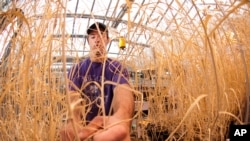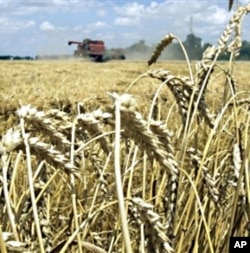Despite wavering global food security, agriculture research could be a casualty in the debate over the U.S. borrowing limit, the latest battleground for advocates demanding deep federal spending cuts.
However, in an unusual twist, the American Enterprise Institute - a leading conservative group - is calling for increased funding for agricultural research to help control soaring food prices. That stands in stark contrast to AEI's other recommendations for farm programs: cut crop subsidies; cut ethanol subsidies; cut crop insurance programs.
In a recommendation he co-wrote for AEI, University of Minnesota economist Phil Pardey says the government should be spending much more - not less - on agricultural research and development.
Slow growth
The threat of more budget cuts comes at a time when yields for major U.S. crops such as wheat, maize, rice and soybeans are dwindling . From the 1950s to the 90s, American harvests grew slowly but steadily, by about two percent each year on average. After 1990, that rate of increase fell by nearly half, says Pardey.
"For those of us who watch these things, that's a really big structural shift," Pardey says, adding the shift has big implications for today's food prices and for tomorrow's food security.
Demand for food from a growing population and the increasing production of biofuels has caught up with the slowing pace of farm productivity gains. With supplies tight, prices have skyrocketed.
Pardey says a big reason for today's high food prices is yesterday's budget cuts. "We've been ratcheting down the rates of growth of R&D spending for many decades here in the U.S."
R&D, research and development, is what scientists do to keep farm productivity growing. Federal R&D funding grew by about four percent per year through the 1950s and 60s. But the pace slowed in the following decades. By the 90s and 2000s it barely kept up with inflation. And Pardey says we're paying for that now.
"If you start slowing down the rate of growth of spending and start re-directing that funding to other things, then the seemingly inevitable consequence is what we're seeing in the data: that is, a slowdown in productivity growth."
Productivity growth needs to be speeding up in order to feed the nine billion people expected on the planet by 2050, Pardey says.
'Shooting ourselves in the foot'
The budget ax has already fallen on Bikram Gill's seed bank at Kansas State University, which holds thousands of varieties of wheat and its wild relatives from around the world.
Funding for the seed bank was cut this spring during an earlier congressional battle over the federal budget.
"What goes through my mind is, 'We are shooting ourselves in the foot,'" he says.
Every time a new threat to wheat production - such as an insect outbreak or a new strain of disease - emerges, researchers comb through Gill's collection for genes that will help them fight back. According to Gill, one wild plant continues to assist U.S. wheat growers.
"They are protected from leaf rust by genes derived from a goat grass collected in Iran," he says. "It's all well-documented."
Gill says the seed bank's million-dollar budget is a small fraction of the hundreds of millions of dollars in economic benefits it provides. But now he's scrambling to find new funding to keep from being shut down.
"This will be very damaging for the long-term improvement of wheat," he says.
Looming cuts
"It's a pretty hard sell to be asking for more money in this budget climate in Washington," says economist Pardey. "But what we're actually asking for is a re-direction of Farm Bill priorities."
However, the priorities of many in Washington lie elsewhere. Last month, Utah Republican Representative Jason Chaffetz proposed cutting the U.S. Department of Agriculture's in-house research budget by two-thirds.
He declined to be interviewed, but in a press release he explained that the country is over $14 trillion in debt, "It’s time for Washington to 'cut cut cut' and be more fiscally disciplined."
The proposal was soundly defeated on bipartisan lines. But few expect agriculture R&D to escape unscathed. Even Democratic President Barack Obama, who recently said, "We can't simply cut our way to prosperity," has proposed cutting the two main agriculture research funds by 8.5 percent.














